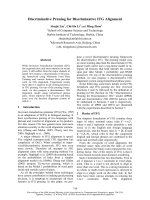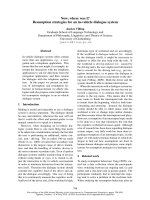Báo cáo khoa học: "Interactive Visualization for Computational Linguistics" doc
Bạn đang xem bản rút gọn của tài liệu. Xem và tải ngay bản đầy đủ của tài liệu tại đây (64.51 KB, 1 trang )
Tutorial Abstracts of ACL-08: HLT, page 6,
Columbus, Ohio, USA, June 2008.
c
2008 Association for Computational Linguistics
Interactive Visualization for Computational Linguistics
Christopher Collins and Gerald Penn
Department of Computer Science
University of Toronto
10 King’s College Road
Toronto, Ontario, Canada
{ccollins,gpenn}@cs.utoronto.ca
Sheelagh Carpendale
Department of Computer Science
University of Calgary
2500 University Dr. NW
Calgary, Canada
Interactive information visualization is an emerg-
ing and powerful research technique that can be used
to understand models of language and their abstract
representations. Much of what computational lin-
guists fall back upon to improve NLP applications
and to model language “understanding” is structure
that has, at best, only an indirect attestation in ob-
servable data. An important part of our research
progress thus depends on our ability to fully investi-
gate, explain, and explore these structures, both em-
pirically and relative to accepted linguistic theory.
The sheer complexity of these abstract structures,
and the observable patterns on which they are based,
usually limits their accessibility — often even to the
researchers creating or attempting to learn them.
To aid in this understanding, visual ‘externaliza-
tions’ are used for presentation and explanation —
traditional statistical graphs and custom-designed il-
lustrations fill the pages of ACL papers. These vi-
sualizations provide post hoc insight into the repre-
sentations and algorithms designed by researchers,
but visualization can also assist in the process of re-
search itself. There are special statistical methods,
falling under the rubric of “exploratory data analy-
sis,” and visualization techniques just for this pur-
pose, in fact, but these are not widely used or even
known in CL. These techniques offer the potential
for revealing structure and detail in data, before any-
one else has noticed them.
When observing natural language engineers at
work, we also notice that, even without a formal vi-
sualization background, they often create sketches
to aid in their understanding and communication of
complex structures. These are ad hoc visualizations,
but they, too, can be extended by taking advantage
of current information visualization research.
This tutorial will enable members of the ACL
community to leverage information visualization
theory into exploratory data analysis, algorithm de-
sign, and data presentation techniques for their own
research. We draw on fundamental studies in cog-
nitive psychology to introduce ‘visual variables’ —
visual dimensions on which data can be encoded.
We also discuss the use of interaction and animation
to enhance the usability and usefulness of visualiza-
tions.
Topics covered in this tutorial include a review of
information visualization techniques that are appli-
cable to CL, pointers to existing visualization tools
and programming toolkits, and new directions in vi-
sualizing CL data and results. We also discuss the
challenges of evaluating visualizations, noting dif-
ferences from the evaluation methods traditionally
used in CL, and discuss some heuristic approaches
and techniques used for measuring insight. Informa-
tion visualizations in CL research can also be mea-
sured by the impact they have on algorithm and data
structure design.
Information visualization is also filled with op-
portunities to make more creative visualizations that
benefit from the CL community’s deeper collective
understanding of natural language. Given that most
visualizations of language are created by researchers
with little or no linguistic expertise, we’ll cover
some open and very ripe possibilities for improving
the state of the art in text-based visualizations.
6









